Optimum Turf Grass Irrigation Requirements and Corresponding Water- Energy-CO2 Nexus across Harris County, Texas
Abstract
:1. Introduction
2. Materials and Methods
2.1. Study Area and Data Used
2.2. Optimum Irrigation Water Requirement for Turf Grass
2.3. Energy Requirement for Irrigation and Carbon Dioxide Emission
3. Results and Discussion
4. Conclusions and Future Work Recommendations
Author Contributions
Funding
Acknowledgments
Conflicts of Interest
References
- TWDB. Water for Texas: 2017 State Water Plan; Texas Water Development Board: Austin, TX, USA, 2017. Available online: http://www.twdb.texas.gov/waterplanning/swp/2017/doc/SWP17-Water-for-Texas.pdf?d=44485.49999995157 (accessed on 24 December 2018).
- Texas Demographic Center. 2017. Available online: http://demographics.texas.gov/Resources/publications/2017/2017_08_21_UrbanTexas.pdf (accessed on 24 December 2018).
- Electric Power Research Institute. Available online: https://www.epri.com/#/?lang=en-US (accessed on 24 December 2018).
- Diehl, T.H.; Melissa, A.H. Withdrawal and Consumption of Water by Thermoelectric Power Plants in the United States, 2010; US Geological Survey: Washington, DC, USA, 2014.
- Saidi, K.; Hammami, S. The impact of CO2 emissions and economic growth on energy consumption in 58 countries. Energy Rep. 2015, 1, 62–70. [Google Scholar] [CrossRef]
- Menyah, K.; Wolde-Rufael, Y. Energy consumption, pollutant emissions and economic growth in South Africa. Energy Econ. 2010, 32, 1374–1382. [Google Scholar] [CrossRef]
- Niu, S.; Ding, Y.; Niu, Y.; Li, Y.; Luo, G. Economic growth, energy conservation and emissions reduction: A comparative analysis based on panel data for 8 Asian-Pacific countries. Energy Policy 2011, 39, 2121–2131. [Google Scholar] [CrossRef]
- Arouri, M.E.; Youssef, A.B.; M’henni, H.; Rault, C. Energy consumption, economic growth and CO2 emissions in Middle East and North African countries. Energy Policy 2012, 45, 342–349. [Google Scholar] [CrossRef]
- Cabrera, R.I.; Wagner, K.L.; Wherley, B.; Lee, L. Urban Landscape Water Use in Texas; TWRI EM-116; Texas Water Resources Institute, Texas A&M University: College Station, TX, USA, 2013. [Google Scholar]
- Hermitte, S.M.; Mace, R.E. The Grass Is Always Greener… Outdoor Residential Water Use in Texas; Technical Note 12-01; Texas Water Development Board: Austin, TX, USA, 2012; p. 43. Available online: https://www.twdb.texas.gov/waterplanning/swp/2017/doc/SWP17-Water-for-Texas.pdf?d=10456.899999990128 (accessed on 24 December 2018).
- Cabrera, R.I.; Wagner, K.L.; Wherley, B. An evaluation of urban landscape water use in Texas. Tex. Water J. 2013, 4, 14–27. [Google Scholar]
- Hu, L.; Brunsell, N.A. The impact of temporal aggregation of land surface temperature data for surface urban heat island (SUHI) monitoring. Remote Sens. Environ. 2013, 134, 162–174. [Google Scholar] [CrossRef]
- Streutker, D.R. A remote sensing study of the urban heat island of Houston, Texas. Int. J. Remote Sens. 2002, 23, 2595–2608. [Google Scholar] [CrossRef] [Green Version]
- Global Weather Data. Available online: http://globalweather.tamu.edu/ (accessed on 24 December 2018).
- Li, X.; Wan, W.; Yu, Y.; Ren, Z. Yearly variations of the stratospheric tides seen in the CFSR reanalysis data. Adv. Space Res. 2015, 56, 1822–1832. [Google Scholar] [CrossRef]
- Tomy, T.; Sumam, K. Determining the Adequacy of CFSR Data for Rainfall-Runoff Modeling Using SWAT. Procedia Technol. 2016, 24, 309–316. [Google Scholar] [CrossRef]
- Blacutt, L.A.; Herdies, D.L.; de Gonçalves, L.G.G.; Vila, D.A.; Andrade, M. Precipitation comparison for the CFSR, MERRA, TRMM3B42 and Combined Scheme datasets in Bolivia. Atmos. Res. 2015, 163, 117–131. [Google Scholar] [CrossRef] [Green Version]
- Allen, R.G.; Pereira, L.S.; Raes, D.; Smith, M. Crop Evapotranspiration-Guidelines for Computing Crop Water Requirements-FAO Irrigation and Drainage Paper 56; FAO: Rome, Italy, 1998. [Google Scholar]
- Soil Survey Geographic (SSURGO) Database. Available online: https://websoilsurvey.sc.egov.usda.gov (accessed on 24 December 2018).
- Fares, A.; Fares, S. Irrigation Management System, IManSys, a user-friendly computer based water management software package. In Proceedings of the Irrigation Show and Education Conference, Orlando, FL, USA, 2 November 2012. [Google Scholar]
- Fares, A.; Awal, R.; Valenzuela, H.; Fares, S.; Johnson, A.B.; Dogan, A.; Nagata, N. Effect of Irrigation Systems and Landscape Species on Irrigation Water Requirements Simulated by the Irrigation Management System (IManSys). In Proceedings of the Irrigation Show and Education Conference, Austin, TX, USA, 4–8 November 2013. [Google Scholar]
- Fares, A.; Awal, R.; Fares, S.; Johnson, A.; Valenzuela, H. Irrigation Water Requirements for Seed Corn and Coffee under Potential Climate Change Scenarios. J. Water Clim. Chang. 2015, 7, 39–51. [Google Scholar] [CrossRef]
- Fares, A.; Bayabil, H.K.; Zekri, M.; de Mattos, D.; Awal, R. Potential climate change impacts on citrus water requirement across major producing areas in the world. J. Water Clim. Chang. 2017, 8, 576–592. [Google Scholar] [CrossRef] [Green Version]
- Fares, A. Water Management Software to Estimate Crop Irrigation Requirements for Consumptive Use Permitting in Hawaii Version 2.0; Report for Commission on Water Resources Management; The University of Hawai’i at Māno: Honolulu, HI, USA, 2013; p. 58. [Google Scholar]
- Smajstrla, A.G.; Zazueta, F.S. Estimating Irrigation Requirements of Sprinkler Irrigated Container Nurseries. Proc. Fla. State Hort. Soc. 1987, 100, 343–348. [Google Scholar]
- Smajstrla, A.G.; Zazueta, F.S. Simulation of irrigation requirements of Florida agronomic crops. Soil Crop Sci. Soc. Florida Proc. 1988, 47, 78–82. [Google Scholar]
- EPA. Strategies for Saving Energy at Public Water Systems. EPA 816-F-13-004; 2013. Available online: https://www.epa.gov/sites/production/files/2015-04/documents/epa816f13004.pdf (accessed on 24 December 2018).
- ERCOT. 2015. Available online: http://www.ercot.com/content/wcm/lists/114739/ERCOT_Quick_Facts_22317.pdf (accessed on 24 December 2018).
- Sovacool, B.K. Valuing the greenhouse gas emissions from nuclear power: A critical survey. Energy Policy 2008, 36, 2950–2963. [Google Scholar] [CrossRef]
- U.S. Energy Information Administration (USEIA). Available online: https://www.eia.gov/ (accessed on 24 December 2018).
- Texas Water Development Board (TWRD). Water Use of Texas Water Utilities, A Biennial Report to the 84th Texas Legislature. January 2015. Available online: http://www.twdb.texas.gov/publications/reports/special_legislative_reports/doc/2014_WaterUseOfTexasWaterUtilities.pdf (accessed on 24 December 2018).
- U.S. Department of Energy. Available online: https://www.energy.gov/articles/how-much-do-you-consume (accessed on 24 December 2018).

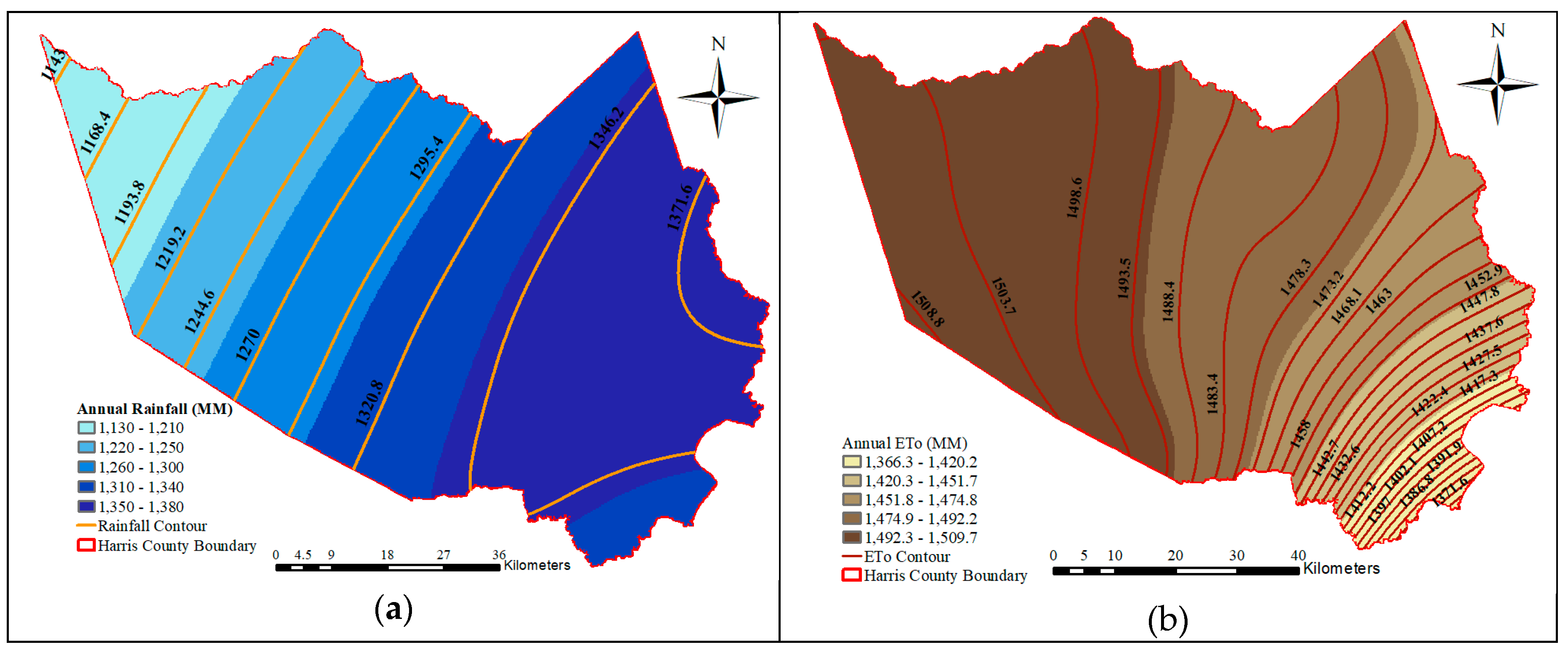
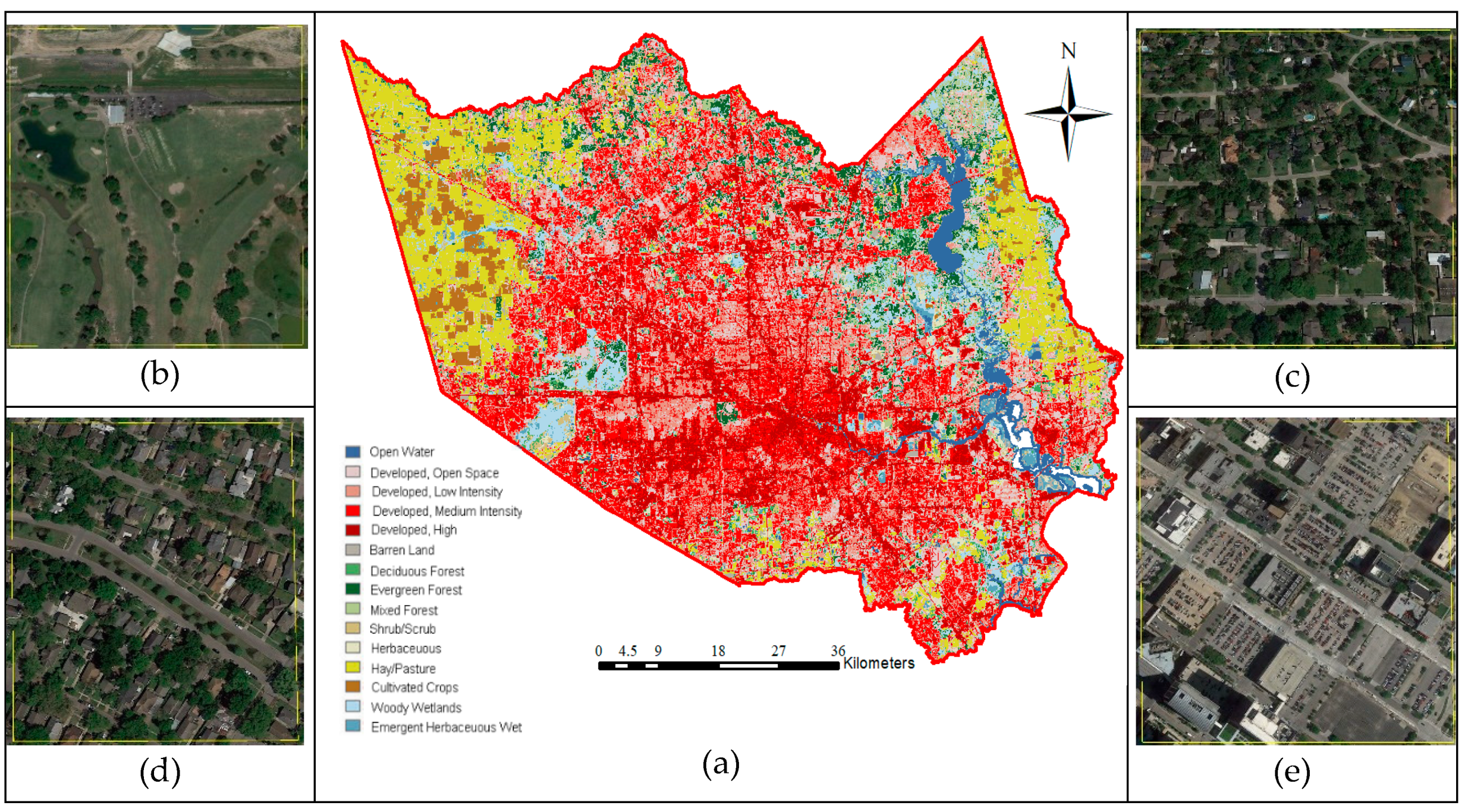
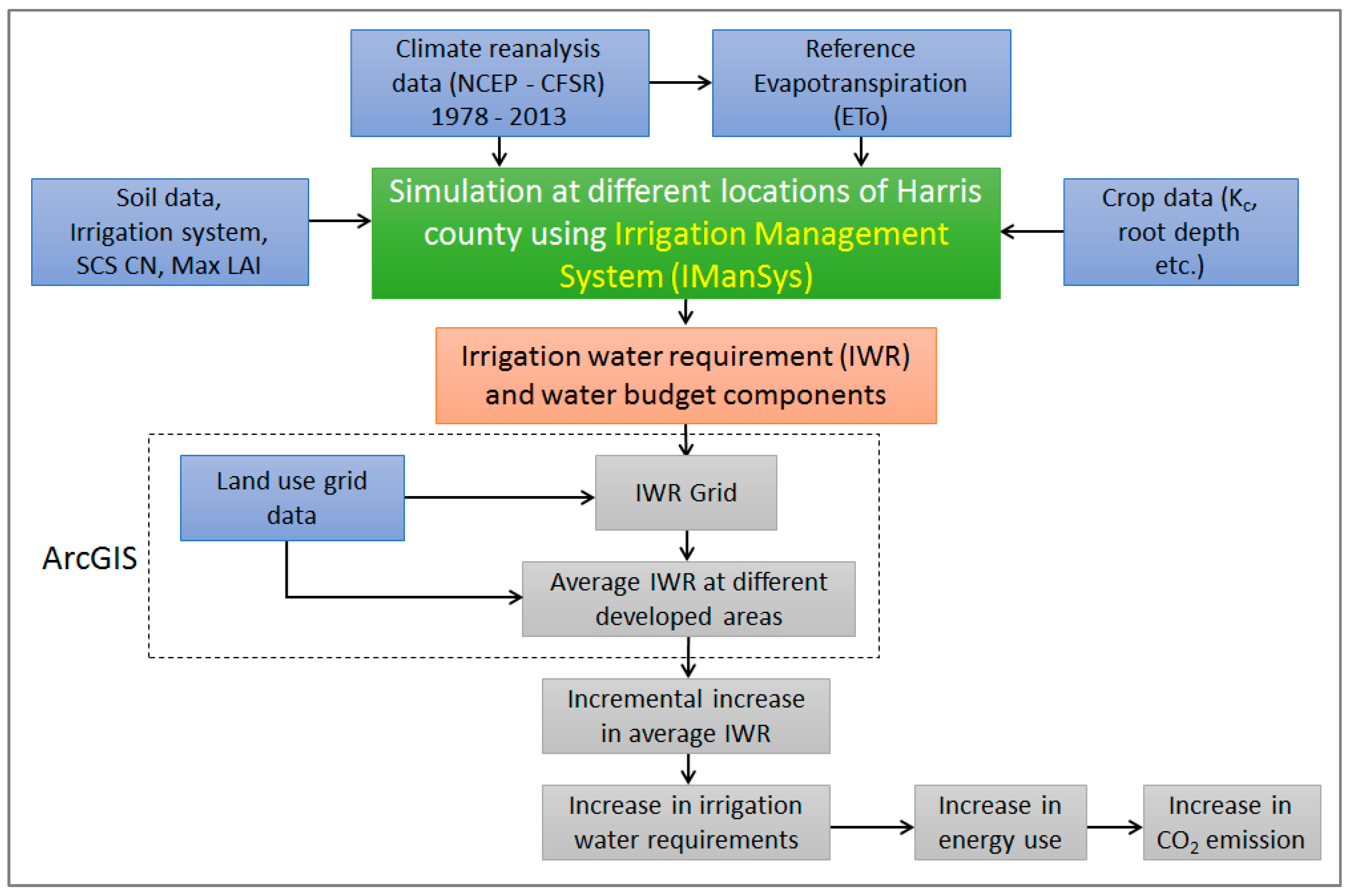
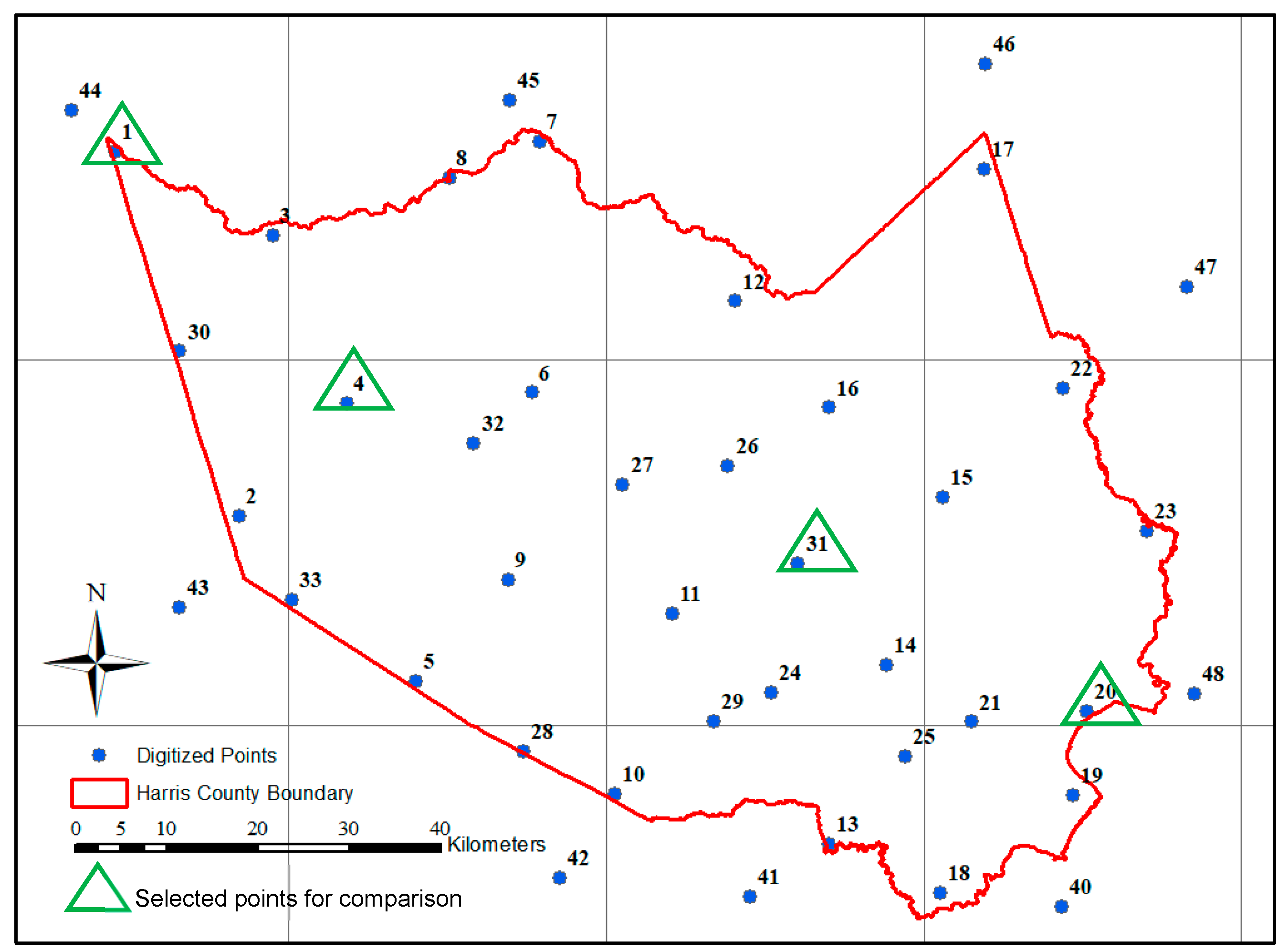
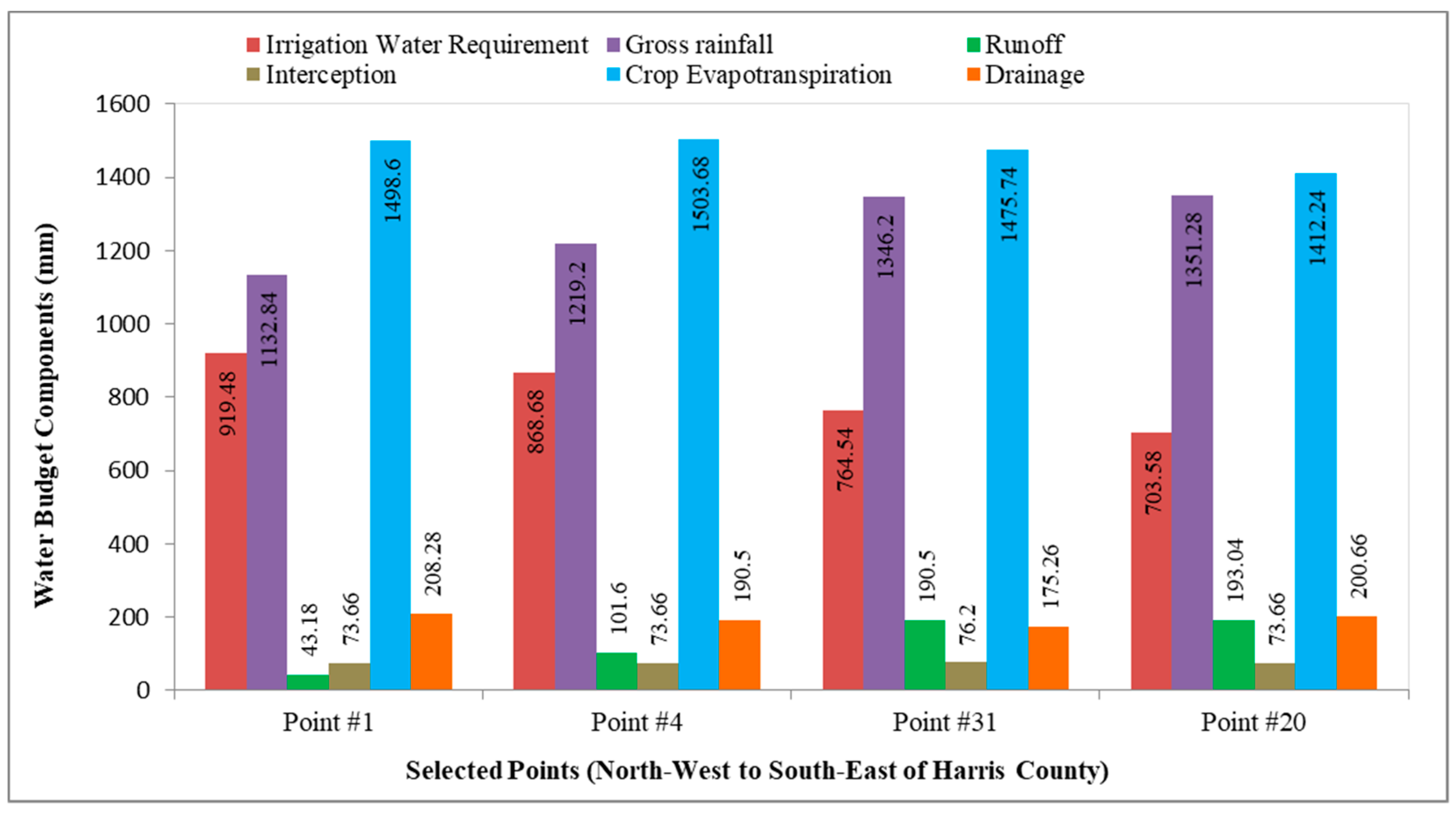
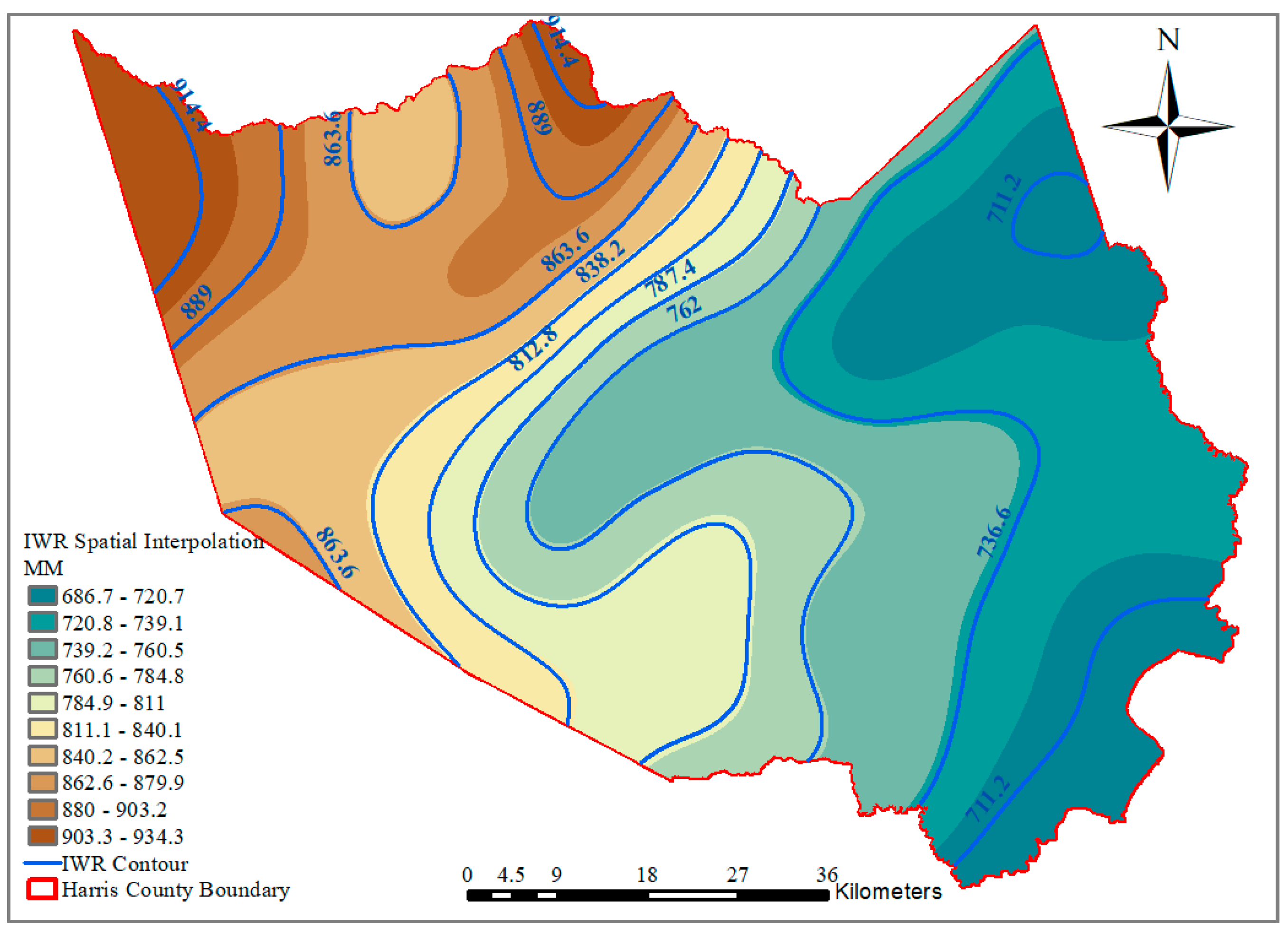

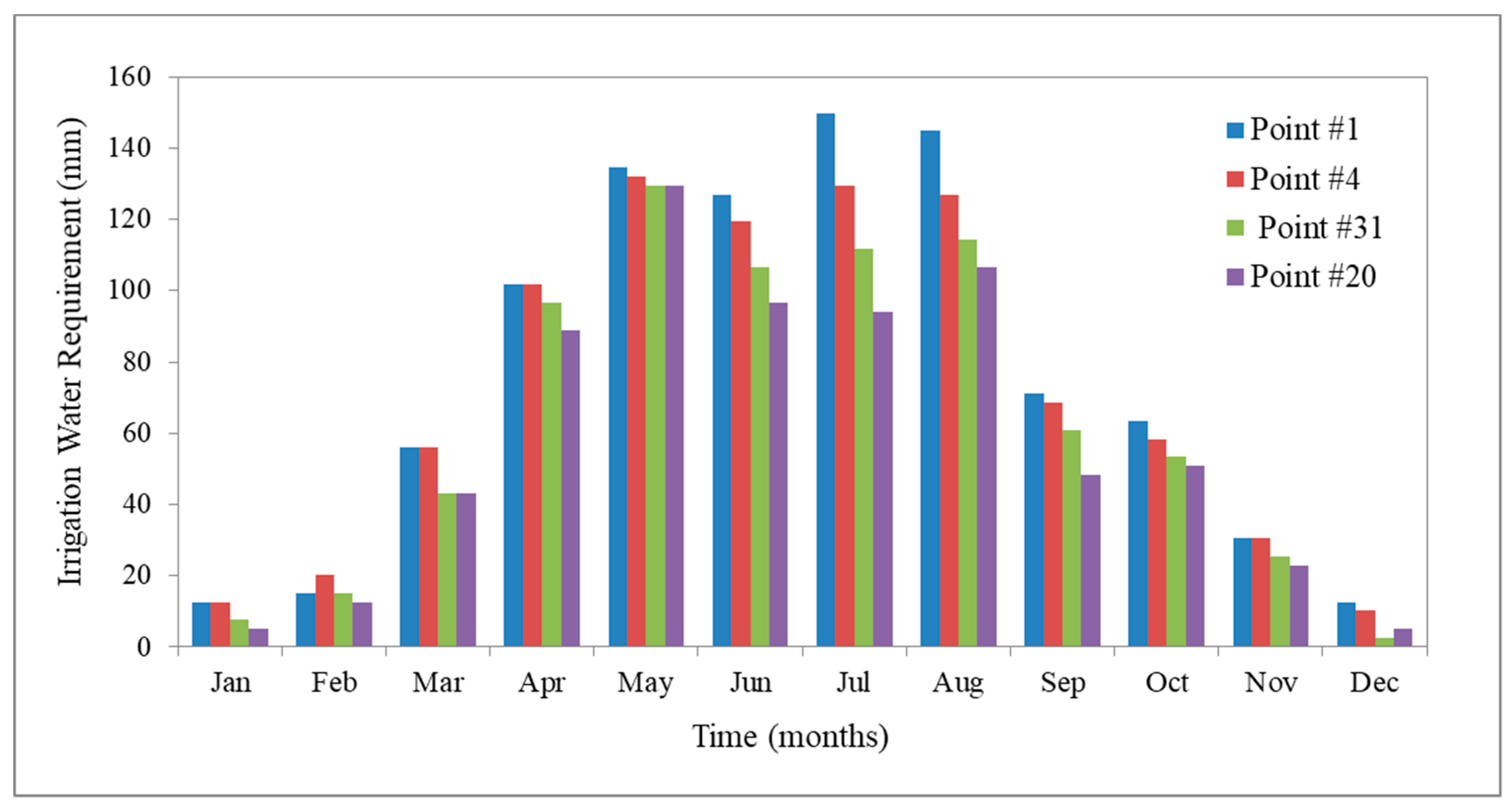
| Land Cover | Total Area (km2) | Estimated Irrigated Area (%) | Annual Average IWR (mm) | Annual Average IWR (million m3) | Annual Average IWR(%) |
|---|---|---|---|---|---|
| Developed, Open Space | 592 | 10 | 783 | 46 | 14.3 |
| Developed, Low Intensity | 760 | 30 | 783 | 179 | 55.5 |
| Developed, Medium Intensity | 1007 | 10 | 789 | 79 | 24.6 |
| Developed, High Intensity | 467 | 5 | 776 | 18 | 5.6 |
| Total | 2827 | - | - | 323 | - |
| Annual Average IWR (Water Depth) | Annual Average IWR (Water Volume) | Annual Increase (Water Volume) | Ground Water (33%) | Surface Water (67%) | Energy for Ground Water | Energy for Surface Water | Total Energy | Total CO2 |
|---|---|---|---|---|---|---|---|---|
| (mm) | (M m3) | (M m3) | (M m3) | (M m3) | MWh | MWh | MWh | Metric Ton |
| 783 | 323 | Optimum IWR for Turf Grass (developed areas, Harris County) | ||||||
| 808 | 333 | 10 | 3 | 7 | 1639 | 2774 | 4413 | 2599 |
| 834 | 343 | 21 | 7 | 14 | 3279 | 5547 | 8826 | 5198 |
| 859 | 354 | 31 | 10 | 21 | 4918 | 8321 | 13,239 | 7796 |
| 884 | 364 | 42 | 14 | 28 | 6558 | 11,095 | 17,652 | 10,395 |
| 910 | 375 | 52 | 17 | 35 | 8197 | 13,869 | 22,065 | 12,994 |
© 2019 by the authors. Licensee MDPI, Basel, Switzerland. This article is an open access article distributed under the terms and conditions of the Creative Commons Attribution (CC BY) license (http://creativecommons.org/licenses/by/4.0/).
Share and Cite
Awal, R.; Fares, A.; Habibi, H. Optimum Turf Grass Irrigation Requirements and Corresponding Water- Energy-CO2 Nexus across Harris County, Texas. Sustainability 2019, 11, 1440. https://doi.org/10.3390/su11051440
Awal R, Fares A, Habibi H. Optimum Turf Grass Irrigation Requirements and Corresponding Water- Energy-CO2 Nexus across Harris County, Texas. Sustainability. 2019; 11(5):1440. https://doi.org/10.3390/su11051440
Chicago/Turabian StyleAwal, Ripendra, Ali Fares, and Hamideh Habibi. 2019. "Optimum Turf Grass Irrigation Requirements and Corresponding Water- Energy-CO2 Nexus across Harris County, Texas" Sustainability 11, no. 5: 1440. https://doi.org/10.3390/su11051440






